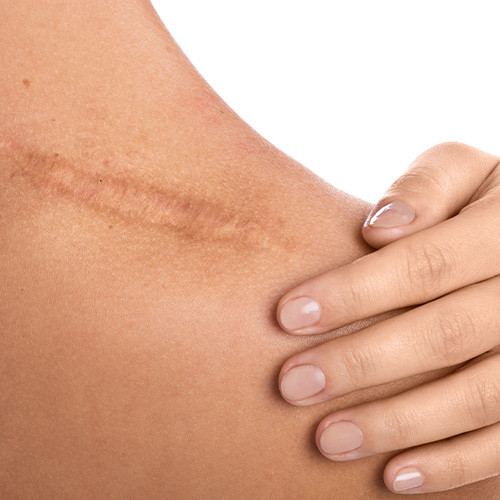We know time heals all wounds, but what about the scars left behind? With our gold standard technology we can reduce (sometimes even erase) new to older scars. We have a number of treatments to improve raised scars, depressed scars, acne scars, pigmented scars, and even stretch marks. You don’t have to be bothered by unwanted scars any longer.
Scars are a part of the natural healing process of the body. Raised scars, also called hypertrophic or keloid scars, result from excess collagen formation after any skin injury, such as acne, piercings, incisions, or burns. They often form after trauma to the skin, but can also appear spontaneously. They can be found anywhere on the body, but most commonly occur on the back, chest, and upper arms.

Individuals with darker skin types are more prone to hypertrophic and keloid scars, as well as those diagnosed with severe acne and hidradenitis suppurativa.
The majority of scars can be decreased to some extent. Treating fresher scars will have more optimal results than older ones that may need multiple treatments to achieve results. How a scar responds to treatment depends on location, size, and type.
It is best to wait until the scar has completely healed after the damage has taken place, which can take as little as 3 or as long as 18 months in some individuals, depending on the severity of the scar.
Topicals can help reduce scar appearance. Silicone is a well-known ingredient to flatten scars by hydrating and reducing the excess collagen formation causing the fibrous tissue.
Depending on the type of scar, it may come back after treatment. Keloids often recur. Other factors like aging, lifestyle, and sun exposure can affect the overall appearance of the skin.
Those who are prone to scarring or keloids should avoid medically unnecessary procedures if possible, such as piercings, tattoos, and cosmetic mole removals. The injured area should be kept covered to prevent further trauma. Also, it is important to avoid sun exposure to the scar during the healing period to avoid hyperpigmentation.
PRODUCT RECOMMENDATIONS
November 24 – December 1st
Save up to 25% OFF SKIN gift cards and use them on your favourites all year long.